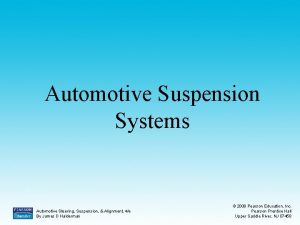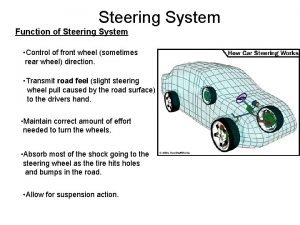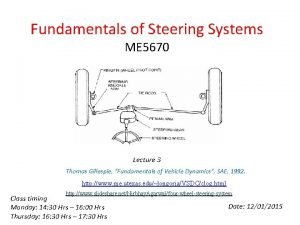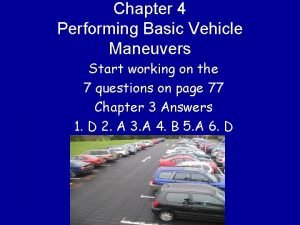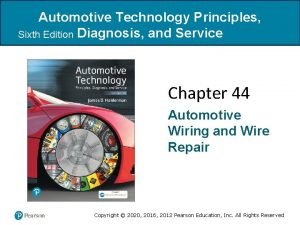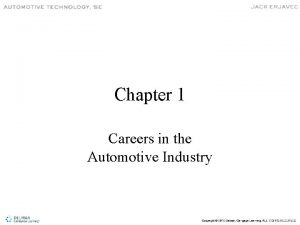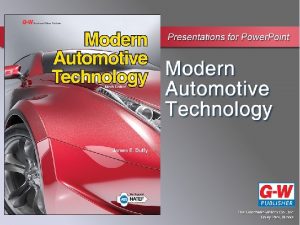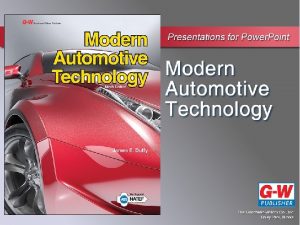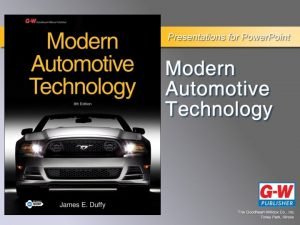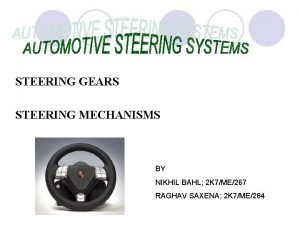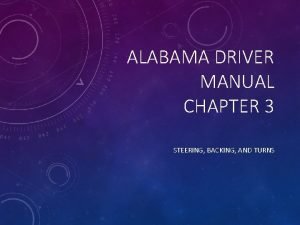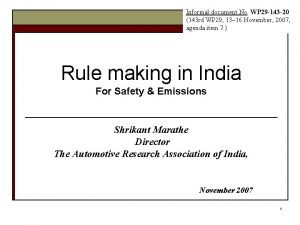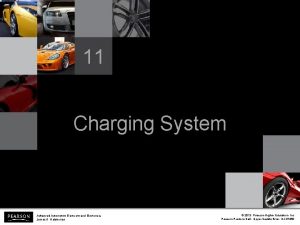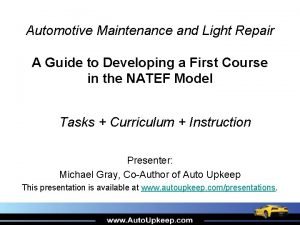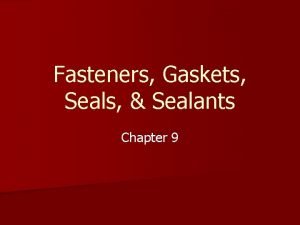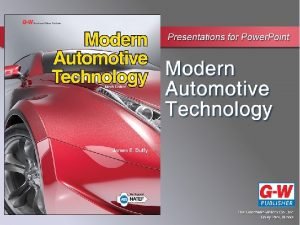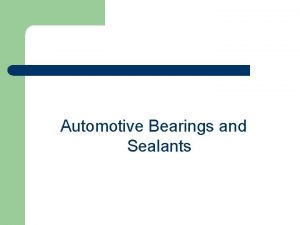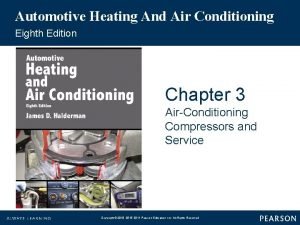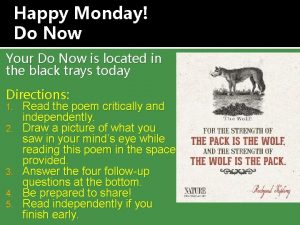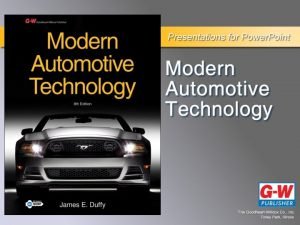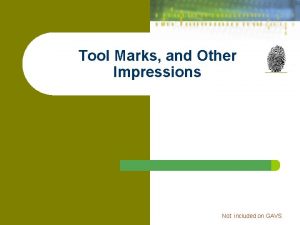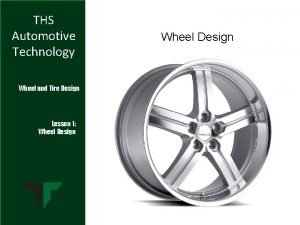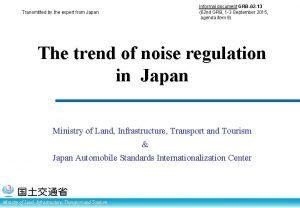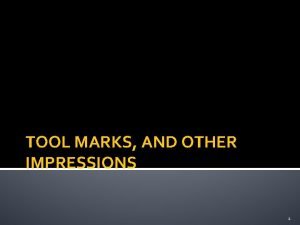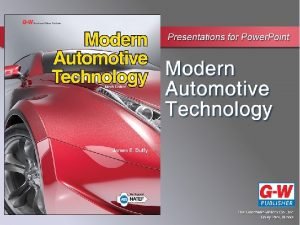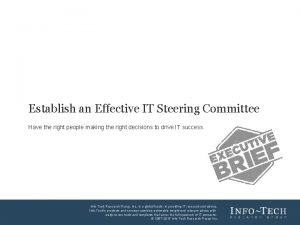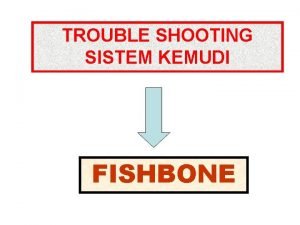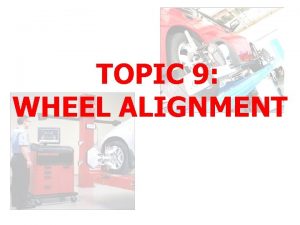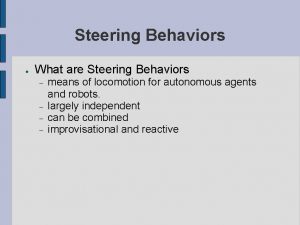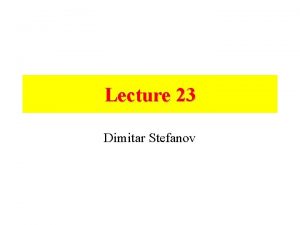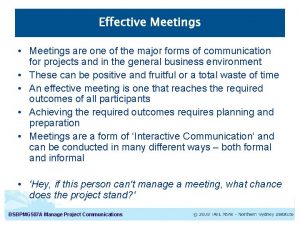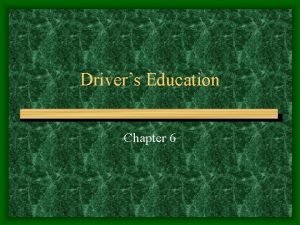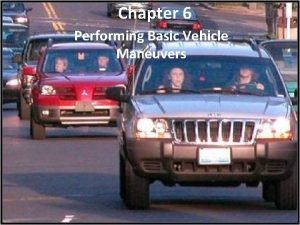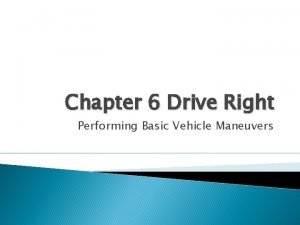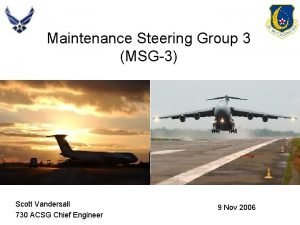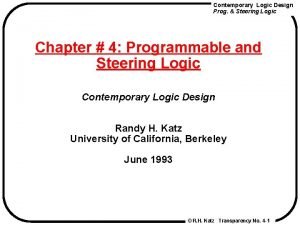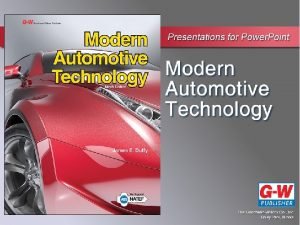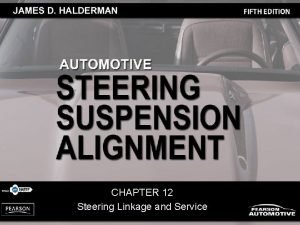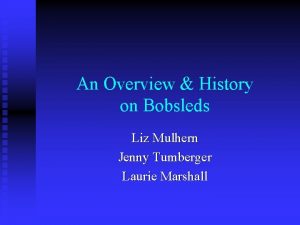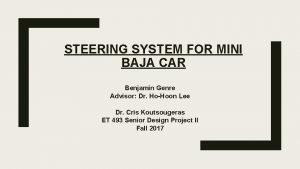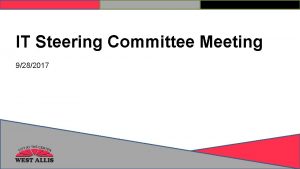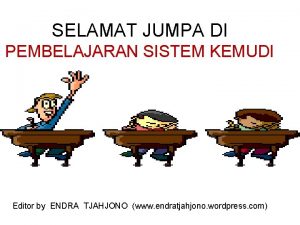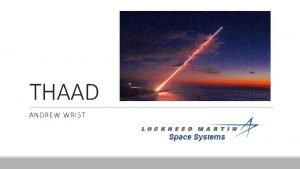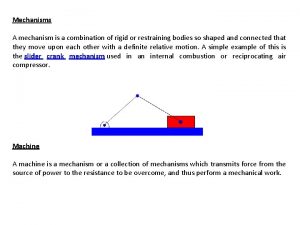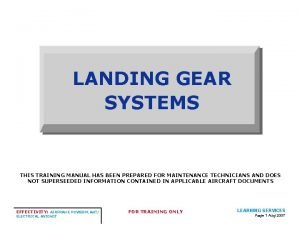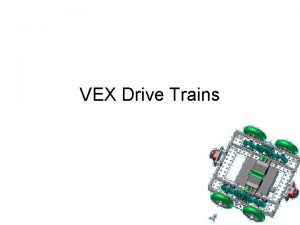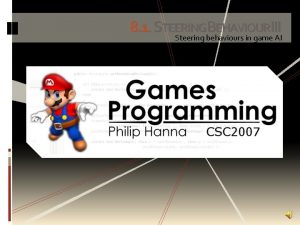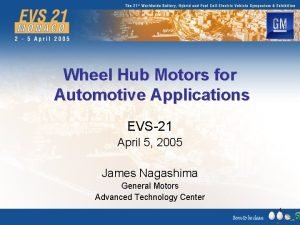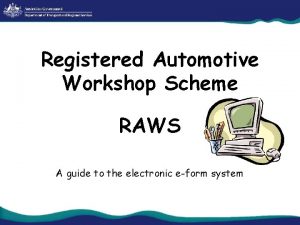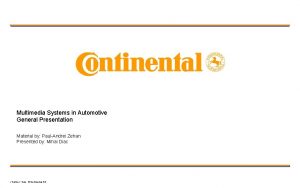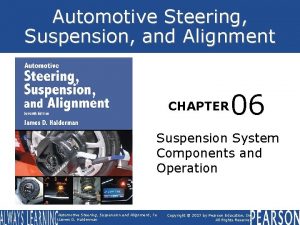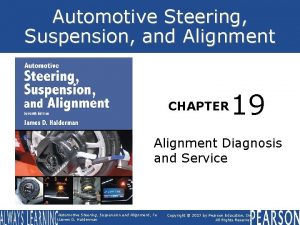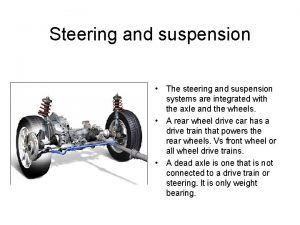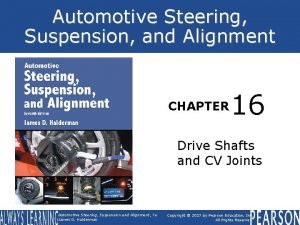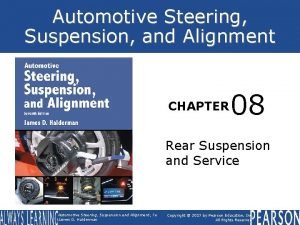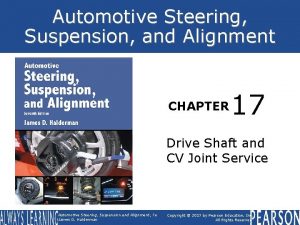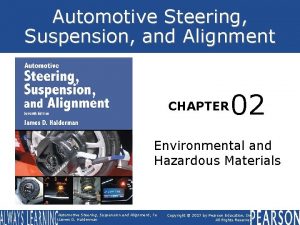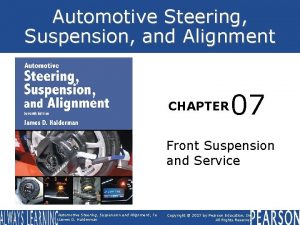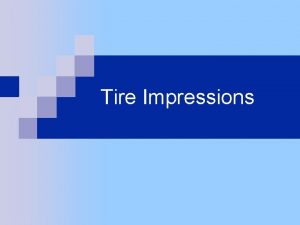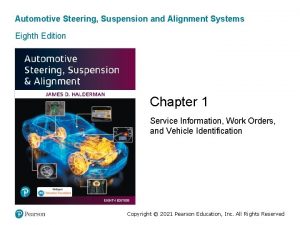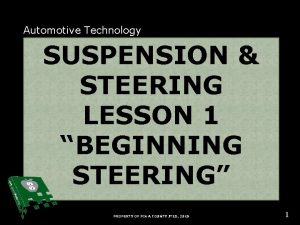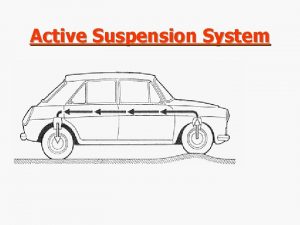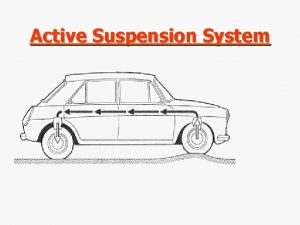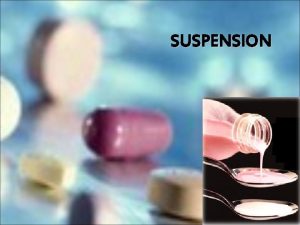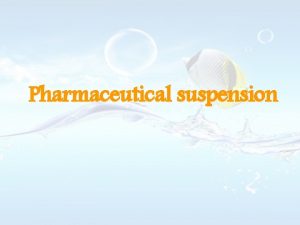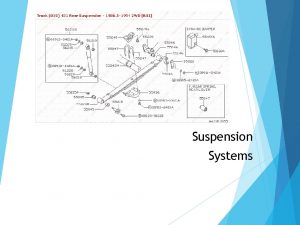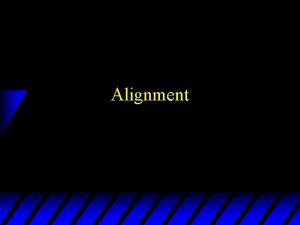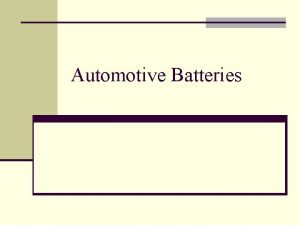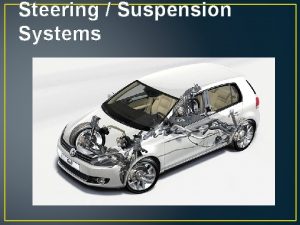Automotive Steering Suspension and Alignment CHAPTER 05 Tire








































































- Slides: 72

Automotive Steering, Suspension, and Alignment CHAPTER 05 Tire and Wheel Service Automotive Steering, Suspension and Alignment, 7 e James D. Halderman Copyright © 2017 by Pearson Education, Inc. All Rights Reserved

FIGURE 5. 1 Using soapy water from a spray bottle is an easy method to find the location of an air leak from a tire. Automotive Steering, Suspension and Alignment, 7 e James D. Halderman Copyright © 2017 by Pearson Education, Inc. All Rights Reserved

FIGURE 5. 2 Chart showing the relationship between tire inflation pressure and load capacity of the tire. Automotive Steering, Suspension and Alignment, 7 e James D. Halderman Copyright © 2017 by Pearson Education, Inc. All Rights Reserved

FIGURE 5. 3 Note that a drop in inflation pressure has a major effect on fuel economy. Automotive Steering, Suspension and Alignment, 7 e James D. Halderman Copyright © 2017 by Pearson Education, Inc. All Rights Reserved

FIGURE 5. 4 Note that if a tire is underinflated by 5 PSI, the life expectancy is reduced by 20% and by about 40% if the inflation pressure is less than specified by 10 PSI. Automotive Steering, Suspension and Alignment, 7 e James D. Halderman Copyright © 2017 by Pearson Education, Inc. All Rights Reserved

FIGURE 5. 5 A temporary inflation pump that uses 12 volts from the cigarette lighter to inflate the tire. Automotive Steering, Suspension and Alignment, 7 e James D. Halderman Copyright © 2017 by Pearson Education, Inc. All Rights Reserved

FIGURE 5. 6 Many vehicle manufacturers include an aerosol can of sealer on vehicles that are not equipped with a conventional spare tire. Automotive Steering, Suspension and Alignment, 7 e James D. Halderman Copyright © 2017 by Pearson Education, Inc. All Rights Reserved

FIGURE 5. 7 Most shops that use nitrogen inflation install a green tire valve cap to let others know that nitrogen, rather than air, has been used to inflate the tire. Automotive Steering, Suspension and Alignment, 7 e James D. Halderman Copyright © 2017 by Pearson Education, Inc. All Rights Reserved

FIGURE 5. 8 Excessively worn tire showing the belt material on the inside edge. This tire requires replacement. Automotive Steering, Suspension and Alignment, 7 e James D. Halderman Copyright © 2017 by Pearson Education, Inc. All Rights Reserved

FIGURE 5. 9 A bulge in a tire as a result of either an injury to the sidewall, such as contact with a curb, or an internal fault in the tire. This tire requires replacement. Automotive Steering, Suspension and Alignment, 7 e James D. Halderman Copyright © 2017 by Pearson Education, Inc. All Rights Reserved

FIGURE 5. 10 Wear on the outside shoulder only is an indication of an alignment problem. Automotive Steering, Suspension and Alignment, 7 e James D. Halderman Copyright © 2017 by Pearson Education, Inc. All Rights Reserved

FIGURE 5. 11 A display at a Lexus dealer used to show customers a visual representation of what a tire looks like at various tread depth amounts. Automotive Steering, Suspension and Alignment, 7 e James D. Halderman Copyright © 2017 by Pearson Education, Inc. All Rights Reserved

FIGURE 5. 12 Always tighten wheel lug nuts (or studs) in a star pattern to ensure even pressure on the axle flange, brake rotors or drums, and the wheel itself. Automotive Steering, Suspension and Alignment, 7 e James D. Halderman Copyright © 2017 by Pearson Education, Inc. All Rights Reserved

FIGURE 5. 13 Most manufacturers recommend using hand tools rather than an air impact wrench to remove and install lock-type lug nuts to prevent damage. Automotive Steering, Suspension and Alignment, 7 e James D. Halderman Copyright © 2017 by Pearson Education, Inc. All Rights Reserved

FIGURE 5. 14 A torque wrench being used to tighten lug nuts on a pickup truck. Automotive Steering, Suspension and Alignment, 7 e James D. Halderman Copyright © 2017 by Pearson Education, Inc. All Rights Reserved

FIGURE 5. 15 A torque-limiting adapter (torque stick) used with an air impact wrench still requires care to prevent overtightening. Automotive Steering, Suspension and Alignment, 7 e James D. Halderman Copyright © 2017 by Pearson Education, Inc. All Rights Reserved

FIGURE 5. 16 This wheel was damaged because the lug nuts were not properly torqued. Automotive Steering, Suspension and Alignment, 7 e James D. Halderman Copyright © 2017 by Pearson Education, Inc. All Rights Reserved

FIGURE 5. 17 The method most often recommended is the modified X method. In this method, each tire eventually is used at each of the four wheel locations. Automotive Steering, Suspension and Alignment, 7 e James D. Halderman Copyright © 2017 by Pearson Education, Inc. All Rights Reserved

FIGURE 5. 18 A tire runout gauge being used to measure the radial runout of a tire. Automotive Steering, Suspension and Alignment, 7 e James D. Halderman Copyright © 2017 by Pearson Education, Inc. All Rights Reserved

FIGURE 5. 19 To check wheel radial runout, the dial indicator plunger tip rides on a horizontal surface of the wheel, such as the bead seat. Automotive Steering, Suspension and Alignment, 7 e James D. Halderman Copyright © 2017 by Pearson Education, Inc. All Rights Reserved

FIGURE 5. 20 To check lateral runout, the dial indicator plunger tip rides on a vertical surface of the wheel, such as the wheel flange. Automotive Steering, Suspension and Alignment, 7 e James D. Halderman Copyright © 2017 by Pearson Education, Inc. All Rights Reserved

FIGURE 5. 21 The most accurate method of measuring wheel runout is to dismantle the tire and take dial indicator readings on the inside of the wheel rim. Automotive Steering, Suspension and Alignment, 7 e James D. Halderman Copyright © 2017 by Pearson Education, Inc. All Rights Reserved

FIGURE 5. 22 Cleaning the bead seat of an alloy wheel using an abrasive pad. Automotive Steering, Suspension and Alignment, 7 e James D. Halderman Copyright © 2017 by Pearson Education, Inc. All Rights Reserved

FIGURE 5. 23 When installing a tire-pressure monitoring system sensor, be sure that the flat part of the sensor is parallel to the center section of the rim. Automotive Steering, Suspension and Alignment, 7 e James D. Halderman Copyright © 2017 by Pearson Education, Inc. All Rights Reserved

FIGURE 5. 24 Many new tires have painted dots placed there at the tire manufacturer. Automotive Steering, Suspension and Alignment, 7 e James D. Halderman Copyright © 2017 by Pearson Education, Inc. All Rights Reserved

FIGURE 5. 25 Always check the wording on tires and install them correctly to insure that the tire performs as designed. Automotive Steering, Suspension and Alignment, 7 e James D. Halderman Copyright © 2017 by Pearson Education, Inc. All Rights Reserved

FIGURE 5. 26 Note the difference in the shape of the rim contour of the 16 inch and 16 1/2 inch diameter wheels. While it is possible to mount a 16 inch tire on a 16 1/2 inch rim, it cannot be inflated enough to seat against the rim flange. Automotive Steering, Suspension and Alignment, 7 e James D. Halderman Copyright © 2017 by Pearson Education, Inc. All Rights Reserved

FIGURE 5. 27 Rendered (odorless) animal fat is recommended by some manufacturers of tire changing equipment for use as a rubber lubricant. Automotive Steering, Suspension and Alignment, 7 e James D. Halderman Copyright © 2017 by Pearson Education, Inc. All Rights Reserved

FIGURE 5. 28 A wheel balancer detects heavy spots on the wheel and tire, and indicates where to place weight to offset both static and dynamic imbalance. Automotive Steering, Suspension and Alignment, 7 e James D. Halderman Copyright © 2017 by Pearson Education, Inc. All Rights Reserved

FIGURE 5. 29 An assortment of wheel weights designed to fit different shaped rims. Automotive Steering, Suspension and Alignment, 7 e James D. Halderman Copyright © 2017 by Pearson Education, Inc. All Rights Reserved

FIGURE 5. 30 A Using a rim gauge can be a little tricky as the shape may appear to match several patterns on the rim gauge. This “AW” shape is not a good match. Automotive Steering, Suspension and Alignment, 7 e James D. Halderman Copyright © 2017 by Pearson Education, Inc. All Rights Reserved

FIGURE 5. 30 B Using the gauge shape for “MC” appears to be a perfect match to their rim flange. Automotive Steering, Suspension and Alignment, 7 e James D. Halderman Copyright © 2017 by Pearson Education, Inc. All Rights Reserved

FIGURE 5. 31 Stick-on weights are used from the factory to balance the alloy wheels of this vehicle. Automotive Steering, Suspension and Alignment, 7 e James D. Halderman Copyright © 2017 by Pearson Education, Inc. All Rights Reserved

FIGURE 5. 32 Wheel weight pliers are specially designed to remove and install wheel weights. Automotive Steering, Suspension and Alignment, 7 e James D. Halderman Copyright © 2017 by Pearson Education, Inc. All Rights Reserved

FIGURE 5. 33 A tire balancer that can also detect radial and lateral force variation and instruct the operator where to rotate the tire to achieve the best ride, or indicate a bent wheel. Automotive Steering, Suspension and Alignment, 7 e James D. Halderman Copyright © 2017 by Pearson Education, Inc. All Rights Reserved

FIGURE 5. 34 Liquid tire stop leak was found in all four tires. This liquid caused the tires to be out of balance. Automotive Steering, Suspension and Alignment, 7 e James D. Halderman Copyright © 2017 by Pearson Education, Inc. All Rights Reserved

FIGURE 5. 35 A pin plate adapter that is designed to support the wheel/tire assembly on a tire balancer instead of using a centering cone. Automotive Steering, Suspension and Alignment, 7 e James D. Halderman Copyright © 2017 by Pearson Education, Inc. All Rights Reserved

FIGURE 5. 36 A A hubcentric plastic ring partially removed from an aftermarket wheel. Automotive Steering, Suspension and Alignment, 7 e James D. Halderman Copyright © 2017 by Pearson Education, Inc. All Rights Reserved

FIGURE 5. 36 B A hubcentric plastic ring left on the hub when removing a wheel. Automotive Steering, Suspension and Alignment, 7 e James D. Halderman Copyright © 2017 by Pearson Education, Inc. All Rights Reserved

FIGURE 5. 37 A tire should only be repaired if the hole is within the tire puncture repair area. Do not make a repair that is located in the shoulder or belt edge part of the tire. Automotive Steering, Suspension and Alignment, 7 e James D. Halderman Copyright © 2017 by Pearson Education, Inc. All Rights Reserved

FIGURE 5. 38 A stitching tool being used to force any trapped air out from under the patch. Automotive Steering, Suspension and Alignment, 7 e James D. Halderman Copyright © 2017 by Pearson Education, Inc. All Rights Reserved

FIGURE 5. 39 A rubber plug being pulled through a hole in the tire. The stem is then cut off flush with the surface of the tire tread. Automotive Steering, Suspension and Alignment, 7 e James D. Halderman Copyright © 2017 by Pearson Education, Inc. All Rights Reserved

A typical tire-changing machine showing the revolving table and movable arm used to remove a tire from the wheel. Automotive Steering, Suspension and Alignment, 7 e James D. Halderman Copyright © 2017 by Pearson Education, Inc. All Rights Reserved

The foot-pedal controls allow the service technician to break the tire bead, damp the wheel (rim) to the machine, rotate the tire/wheel assembly, and still have both hands free. Automotive Steering, Suspension and Alignment, 7 e James D. Halderman Copyright © 2017 by Pearson Education, Inc. All Rights Reserved

Using a tire valve removal tool, unscrew the valve core using extreme caution because the valve is under pressure and can be forced outward and cause personal injury. Automotive Steering, Suspension and Alignment, 7 e James D. Halderman Copyright © 2017 by Pearson Education, Inc. All Rights Reserved

The valve core removed from the tire valve. Allow all of the air in the tire to escape. Automotive Steering, Suspension and Alignment, 7 e James D. Halderman Copyright © 2017 by Pearson Education, Inc. All Rights Reserved

A bead breaker is being used to separate the tire from the bead seat of the wheel. Repeat as needed to break the bead on both sides of the wheel. Automotive Steering, Suspension and Alignment, 7 e James D. Halderman Copyright © 2017 by Pearson Education, Inc. All Rights Reserved

After breaking the beads from both sides of the tire, install the wheel/tire assembly flat onto the machine and, using the foot-pedal control, lock the wheel to the changer. Automotive Steering, Suspension and Alignment, 7 e James D. Halderman Copyright © 2017 by Pearson Education, Inc. All Rights Reserved

To remove the tire from the wheel, position the arm of the changer against the rim of the wheel and lock in position. Automotive Steering, Suspension and Alignment, 7 e James D. Halderman Copyright © 2017 by Pearson Education, Inc. All Rights Reserved

The tire tool (flat bar) is placed between the bead of the tire and the wheel. Using tire lubricant can help prevent damage to the tire. Automotive Steering, Suspension and Alignment, 7 e James D. Halderman Copyright © 2017 by Pearson Education, Inc. All Rights Reserved

The foot-pedal that causes the table to rotate is depressed and the tire is removed from the wheel. Automotive Steering, Suspension and Alignment, 7 e James D. Halderman Copyright © 2017 by Pearson Education, Inc. All Rights Reserved

Reposition the tire tool to remove the lower bead of the tire from the wheel. Automotive Steering, Suspension and Alignment, 7 e James D. Halderman Copyright © 2017 by Pearson Education, Inc. All Rights Reserved

As the table of the tire changer is rotated, the tire is released from the wheel and can be lifted off the wheel. Automotive Steering, Suspension and Alignment, 7 e James D. Halderman Copyright © 2017 by Pearson Education, Inc. All Rights Reserved

Before installing a tire, inspect and clean the bead seat. Automotive Steering, Suspension and Alignment, 7 e James D. Halderman Copyright © 2017 by Pearson Education, Inc. All Rights Reserved

Before installing a new tire, most experts recommend replacing the tire valve, being installed here, using a tool that pulls the valve through the hole in the wheel. Automotive Steering, Suspension and Alignment, 7 e James D. Halderman Copyright © 2017 by Pearson Education, Inc. All Rights Reserved

Apply tire soap or rubber lubricant to both beads of the tire. Automotive Steering, Suspension and Alignment, 7 e James D. Halderman Copyright © 2017 by Pearson Education, Inc. All Rights Reserved

Rotate the tire on the wheel and position the arm so that the tire will be guided onto the rim as the wheel is rotated. Automotive Steering, Suspension and Alignment, 7 e James D. Halderman Copyright © 2017 by Pearson Education, Inc. All Rights Reserved

Repeat for the upper bead. Automotive Steering, Suspension and Alignment, 7 e James D. Halderman Copyright © 2017 by Pearson Education, Inc. All Rights Reserved

Inflate the tire, being careful to not exceed 40 PSI. Experts suggest that a tire be in a cage during the initial bead seating inflation to help prevent personal injury if the wheel or tire fails. Automotive Steering, Suspension and Alignment, 7 e James D. Halderman Copyright © 2017 by Pearson Education, Inc. All Rights Reserved

Install the tire valve core and inflate the tire to specifications. Automotive Steering, Suspension and Alignment, 7 e James D. Halderman Copyright © 2017 by Pearson Education, Inc. All Rights Reserved

The source of the leak was detected by spraying soapy water on the inflated tire. Needle-nose pliers are being used to remove the object that caused the flat tire. Automotive Steering, Suspension and Alignment, 7 e James D. Halderman Copyright © 2017 by Pearson Education, Inc. All Rights Reserved

A part of a razor blade was found to be the cause of the flat tire. Automotive Steering, Suspension and Alignment, 7 e James D. Halderman Copyright © 2017 by Pearson Education, Inc. All Rights Reserved

A reamer is being used to clean the puncture hole. Automotive Steering, Suspension and Alignment, 7 e James D. Halderman Copyright © 2017 by Pearson Education, Inc. All Rights Reserved

This technician is using two open-end wrenches to hold the tire beads apart if a tire bead spreader is not available. Automotive Steering, Suspension and Alignment, 7 e James D. Halderman Copyright © 2017 by Pearson Education, Inc. All Rights Reserved

The surrounding area is being buffed using an airpowered die grinder equipped with a special buffing tool specifically designed for this process. Automotive Steering, Suspension and Alignment, 7 e James D. Halderman Copyright © 2017 by Pearson Education, Inc. All Rights Reserved

After using a vacuum on all debris and rubber after buffing, apply rubber cement to the area. Automotive Steering, Suspension and Alignment, 7 e James D. Halderman Copyright © 2017 by Pearson Education, Inc. All Rights Reserved

The brush included with the rubber cement makes the job easy. Be sure to cover the entire area around the puncture. Automotive Steering, Suspension and Alignment, 7 e James D. Halderman Copyright © 2017 by Pearson Education, Inc. All Rights Reserved

Peel off the paper from the adhesive on the patch. Insert the tip of the patch through the puncture from the inside of the tire. Automotive Steering, Suspension and Alignment, 7 e James D. Halderman Copyright © 2017 by Pearson Education, Inc. All Rights Reserved

Use a pair of pliers to pull the plug of the patch through the puncture. Automotive Steering, Suspension and Alignment, 7 e James D. Halderman Copyright © 2017 by Pearson Education, Inc. All Rights Reserved

This view of the patch is from the inside of the tire. Automotive Steering, Suspension and Alignment, 7 e James D. Halderman Copyright © 2017 by Pearson Education, Inc. All Rights Reserved

To be assured of an airtight patch, the adhesive of the patch should be “stitched” to the inside of the tire using a serrated roller called a stitching tool. Automotive Steering, Suspension and Alignment, 7 e James D. Halderman Copyright © 2017 by Pearson Education, Inc. All Rights Reserved

A view of the plug from the outside of the tire after metal covering used to pierce the puncture is removed from the patch plug. The plug can be trimmed to the level of the tread using side cutters or a knife. Automotive Steering, Suspension and Alignment, 7 e James D. Halderman Copyright © 2017 by Pearson Education, Inc. All Rights Reserved
 Halderman
Halderman Functions of steering system:
Functions of steering system: Vertical
Vertical Global alignment and local alignment
Global alignment and local alignment Global alignment
Global alignment Difference between local and global alignment
Difference between local and global alignment Sequence alignment
Sequence alignment Global vs local alignment
Global vs local alignment Suspension therapy uses
Suspension therapy uses Chapter 4 performing basic maneuvers
Chapter 4 performing basic maneuvers Chapter 44 automotive wiring and wire repair
Chapter 44 automotive wiring and wire repair Chapter 2 automotive careers and ase certification
Chapter 2 automotive careers and ase certification Tire wheel and wheel bearing fundamentals
Tire wheel and wheel bearing fundamentals Emission control system components
Emission control system components Chapter 76 suspension system diagnosis and repair answers
Chapter 76 suspension system diagnosis and repair answers Bevel gear steering mechanism
Bevel gear steering mechanism Hand over hand steering
Hand over hand steering Allows maximum stopping force without locking up the brakes
Allows maximum stopping force without locking up the brakes Automotive regulations and standards
Automotive regulations and standards Automotive technology sixth edition
Automotive technology sixth edition Advanced automotive electricity and electronics
Advanced automotive electricity and electronics Auto upkeep answer key
Auto upkeep answer key Fasteners gaskets seals and sealants
Fasteners gaskets seals and sealants China automotive technology & research center
China automotive technology & research center Chapter 8 fasteners gaskets seals and sealants
Chapter 8 fasteners gaskets seals and sealants Types of sealants used in automotive
Types of sealants used in automotive Automotive heating and air conditioning 8th edition
Automotive heating and air conditioning 8th edition Jimmy and eric were huddled by the tire swing
Jimmy and eric were huddled by the tire swing Tire wheel and wheel bearing fundamentals
Tire wheel and wheel bearing fundamentals 4.05 quiz: footwear and tire marks
4.05 quiz: footwear and tire marks Wheel tire design
Wheel tire design Scandinavian tire and rim organization
Scandinavian tire and rim organization Unr51
Unr51 First impressions four marks
First impressions four marks Chapter 75
Chapter 75 It steering
It steering Sebutkan 3 penyebab kebebasan roda kemudi yang berlebihan!
Sebutkan 3 penyebab kebebasan roda kemudi yang berlebihan! Front wheel setback
Front wheel setback Craig reynolds steering behaviors
Craig reynolds steering behaviors Steering angle formula
Steering angle formula Orthman tracker
Orthman tracker Steering committee meeting agenda sample
Steering committee meeting agenda sample How to steer straight forward
How to steer straight forward Beam steering
Beam steering Always prepare to straighten your vehicle after a turn by
Always prepare to straighten your vehicle after a turn by Chapter 6 basic maneuvers
Chapter 6 basic maneuvers Strategic steering
Strategic steering Budget steering committee
Budget steering committee Maintenance steering group
Maintenance steering group Steering logic
Steering logic Steering axis inclination
Steering axis inclination Parallelogram steering linkage diagram
Parallelogram steering linkage diagram Bobsled steering system
Bobsled steering system Steering rack mini baja
Steering rack mini baja It steering committee agenda
It steering committee agenda Komponen steering linkage
Komponen steering linkage Curricular areas of ncf 2005
Curricular areas of ncf 2005 Information systems steering committee
Information systems steering committee Auto steering system
Auto steering system Thermally initiated venting system
Thermally initiated venting system Steering in birds
Steering in birds Correct steering equation
Correct steering equation Aircraft landing gear system
Aircraft landing gear system Tank drive vex
Tank drive vex It steering committee
It steering committee Steering behaviours
Steering behaviours Wheel hub motors for automotive applications
Wheel hub motors for automotive applications Dristas utm
Dristas utm Sap s4 hana automotive
Sap s4 hana automotive Raws certified workshop
Raws certified workshop True automotive
True automotive V cycle automotive
V cycle automotive Automotive aftermarket solutions
Automotive aftermarket solutions
